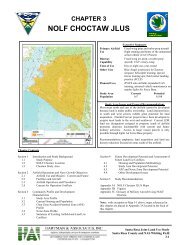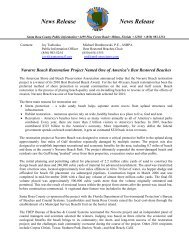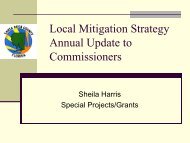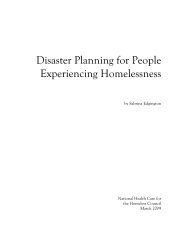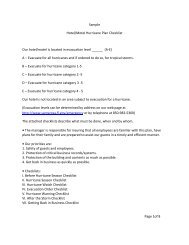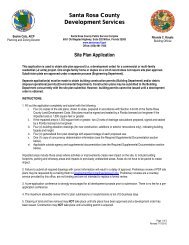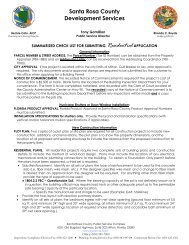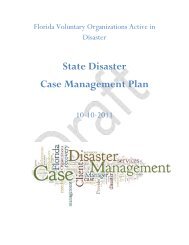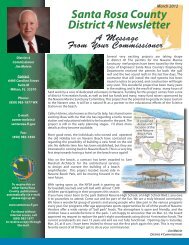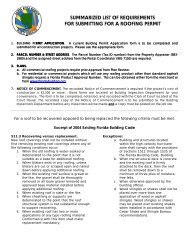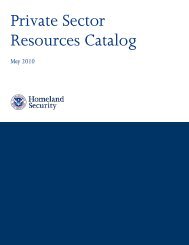Case Management planning fact sheet - Santa Rosa County
Case Management planning fact sheet - Santa Rosa County
Case Management planning fact sheet - Santa Rosa County
- No tags were found...
You also want an ePaper? Increase the reach of your titles
YUMPU automatically turns print PDFs into web optimized ePapers that Google loves.
FACT SHEET:Florida Disaster <strong>Case</strong> <strong>Management</strong> PlanningThe purpose of this Fact Sheet is to describe the concept of operations developed in the Florida Disaster <strong>Case</strong><strong>Management</strong> Planning to date and facilitate discussion regarding future <strong>planning</strong> efforts.Basic PrinciplesThe Florida Disaster <strong>Case</strong> <strong>Management</strong> Basic Plan was developed as a collaborative process by the FloridaVoluntary Organizations Active in Disasters (VOAD), the Florida Division of Emergency <strong>Management</strong>, VolunteerFlorida and Long-Term Recovery Groups. The Plan is written to enable stakeholder organizations to meet the higheststandards of service and has been based upon case studies, lessons learned and National VOAD guidance. As part of this<strong>planning</strong> process, the Florida VOAD Disaster <strong>Case</strong> <strong>Management</strong> Committee has further identified five basic principles toguide the State’s Disaster <strong>Case</strong> <strong>Management</strong> Operations. To be most effective Disaster <strong>Case</strong> <strong>Management</strong> should be:• Coordinated and Collaborative,• Scalable,• Standardized,• Sensitive to functional and access needs, and• Outcome-focused.Roles and ResponsibilitiesRoles and Responsibilities are identified for each stakeholder group. Some of the critical responsibilities include:• Florida VOAD will coordinate guidance to COADs, VOADs, state and local government on programimprovement <strong>planning</strong> and implementation of Disaster <strong>Case</strong> <strong>Management</strong>;• Volunteer Florida will serve as the fiscal administrator for federal Disaster <strong>Case</strong> <strong>Management</strong> funds should theybecome available;• Florida Division of Emergency <strong>Management</strong> will submit the statement of intent to apply for the federal Disaster<strong>Case</strong> <strong>Management</strong> grant in the request for declaration;• The Coordinating <strong>Case</strong> <strong>Management</strong> Organization (from the voluntary sector) will coordinate Disaster <strong>Case</strong><strong>Management</strong> services wherein more than one organization is providing Disaster <strong>Case</strong> <strong>Management</strong> in adisaster-affected community or region.• Long-Term Recovery Groups will manage the community needs assessment process to identify capacity and gapsfor community recovery with support from FEMA and other organizations.Additional responsibilities will be delineated in the <strong>Case</strong>work and federal DCMP Grant Annexes as appropriate.Standardized ElementsThe Florida VOAD Disaster <strong>Case</strong> <strong>Management</strong> Committee identified several elements of Disaster <strong>Case</strong><strong>Management</strong> that require standardization to ensure consistent service to disaster survivors. These elements include:training, confidentiality, personnel qualifications, prioritization & complexity of <strong>Case</strong>s, technology platform, forms/Release of Information, <strong>Case</strong> transition and <strong>Case</strong> closure, non-compliance, how to estimate staffing needs, and conferencecall frequency. Standard Operating Procedures will be developed to guide <strong>Case</strong> Managers through these processes.Other Important Plan DetailsIn order to facilitate effective Disaster <strong>Case</strong> <strong>Management</strong> services, the Planning Committee evaluated options andmade determinations regarding the best practices to follow in Florida. Included below are some of the highlightsdeveloped in this <strong>planning</strong> process:• Assumptionso Florida has a robust network of disaster relief organizations to provide casework services;eliminating the need for Phase I of the federal Disaster <strong>Case</strong> <strong>Management</strong> Program with theexception of catastrophic disasters. (page 4)1
FACT SHEET:Florida Disaster <strong>Case</strong> <strong>Management</strong> Planning• <strong>Case</strong> <strong>Management</strong> Processo Client eligibility will be based on the criteria set by Disaster <strong>Case</strong> <strong>Management</strong> Provider Organizations andLong-Term Recovery Groups in non-declared disasters or the requirements set by the federal Disaster <strong>Case</strong><strong>Management</strong> Program grant when FEMA funded. Ineligible Clients will be referred for advocacy or otherservices. (page 14)o All Clients should be encouraged to take ownership for their own recovery and to participate fully in takingsteps on their own behalf. (page 18)• Program <strong>Management</strong>o Organizations should thoroughly assess their internal capacity to implement a Disaster <strong>Case</strong> <strong>Management</strong>program and consider the implications of such a program prior to involvement. (page 21)o Florida’s Long-Term Recovery Groups are particularly proactive; therefore case management programs mustbe available to provide support early on. (page 23)o All staff, paid or volunteer, should meet the same personnel standards. (page 24)o The recommended ratio of Disaster <strong>Case</strong> Managers to Supervisors is 5 to 1; however this ratio should neverexceed 15 to 1. (page 25)o A caseload of 20-35 Clients per Disaster <strong>Case</strong> Manager is a generally accepted guide. (page 25)• Collaborationo <strong>Case</strong> Managers should be engaged with the community-based Long-Term Recovery Group in order toeffectively access resources for their Clients. (page 30)o Efforts should be made to overcome the challenges of sharing appropriate information with governmentpartners. (page 30)o Best practices suggest that government-provided Disaster <strong>Case</strong> <strong>Management</strong> is not preferred. (page 31)o The Florida recommended case management tool is the Coordinated Assistance Network (CAN). Alternatesystems may be used; however, they must meet minimum requirements. (page 32)• Outreacho Outreach should be coordinated and utilize as many different methods as possible. If activated, theCommunity Coordinator will ensure consistent messaging across outreach groups. (page 33)• Trainingo Florida VOAD recommends all Disaster <strong>Case</strong> Managers and Supervisors complete the United Methodist’sCommittee on Relief’s (UMCOR) Basic Disaster <strong>Case</strong> <strong>Management</strong> training. (page 37)Future PlanningThe Florida VOAD Disaster <strong>Case</strong> <strong>Management</strong> Planning Committee is currently working on the development ofseveral supplements to this Plan, including:• <strong>Case</strong>work Integration Annex• Federal DCMP Grant Annex• Local Implementation Guide• Florida Disaster <strong>Case</strong> <strong>Management</strong> Forms• Standard Operating Procedureso Confidentiality Protectiono <strong>Case</strong> Transitiono <strong>Case</strong> ClosureThe development of these documents will require recommendations and input from the Disaster <strong>Case</strong> <strong>Management</strong>Committee and members of the Florida VOAD at large.2




